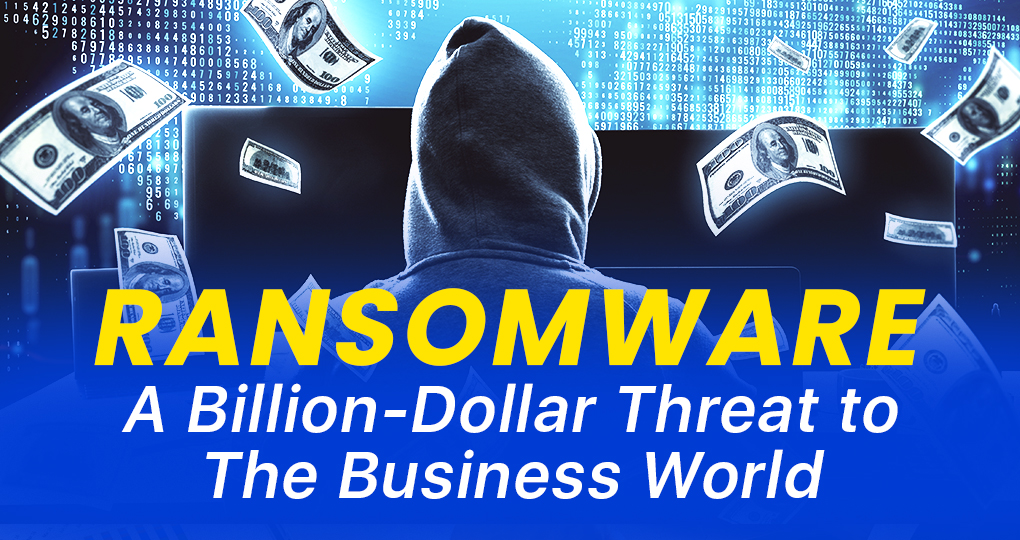Ransomware: A Billion-Dollar Threat to The Business World

Ransomware continues to become more and more profitable for cybercriminals—in fact, they raked in over $1 billion in illicit profits in 2023 alone by using this form of malware. Despite temporary downturns in ransomware profits due to law enforcement interventions, cybercriminals continue to innovate and adapt, unleashing sophisticated attacks that target a wide range of organizations, including hospitals, schools, and government agencies.
These attacks are not just financially motivated; they also have profound implications for the affected businesses. Beyond the immediate financial losses incurred through ransom payments, organizations must also contend with reputational damage and operational disruptions that can have far-reaching consequences.
Additionally, it is crucial to highlight the profound impact ransomware attacks can have on individuals, especially those working in vital sectors such as healthcare and critical infrastructure. These attacks pose potentially life-threatening consequences for organizations, underscoring the urgent need for robust cybersecurity measures.
The Evolution of Ransomware
Ransomware, once considered a relatively straightforward cyber threat, has evolved into a complex and adaptive menace that poses significant risks to businesses worldwide. Over the years, ransomware operators have demonstrated remarkable ingenuity in refining their tactics, making them increasingly difficult for businesses to defend against.
Initially, ransomware attacks relied heavily on indiscriminate phishing emails and exploit kits to infect victims’ systems. However, as cybersecurity measures improved and awareness of these tactics grew, ransomware operators pivoted towards more sophisticated methods. For instance, they began targeting high-value entities such as hospitals, schools, and government agencies through carefully planned and executed attacks.
These targeted campaigns often involve extensive reconnaissance and social engineering, allowing attackers to maximize their impact and demand larger ransom payments. Another notable evolution in ransomware tactics is the rise of supply chain attacks and zero-day exploits.
By targeting trusted third-party vendors or exploiting previously unknown vulnerabilities in popular software, ransomware operators can infect large numbers of victims with relative ease. The Clop group’s supply chain attack, which exploited a zero-day vulnerability in a widely used file-sharing platform, exemplifies this trend. Such attacks not only increase the likelihood of success but also make it more challenging for businesses to defend against ransomware effectively.
Furthermore, the emergence of ransomware-as-a-service (RaaS) models has democratized ransomware operations, enabling even non-technical individuals to launch sophisticated attacks. RaaS platforms provide aspiring cybercriminals with ready-made ransomware tools and infrastructure, lowering the barrier to entry and fueling a surge in ransomware attacks worldwide.
The Escalating Threat Landscape
One notable example of the evolving tactics employed by ransomware groups is the aforementioned supply chain attack by the Clop group, which exploited a zero-day vulnerability in a popular file-sharing platform. By encrypting servers and exfiltrating sensitive data, the group was able to extort over $100 million in ransom payments, demonstrating the financial impact and sophistication of modern ransomware campaigns.
This incident underscores the need for businesses to remain vigilant and proactive in their cybersecurity efforts, as cybercriminals continue to find new ways to exploit vulnerabilities and evade detection. The statistics are alarming: over 70% of ransom payments in 2023 exceeded $1 million, highlighting the substantial sums at stake for businesses that fall victim to these attacks.
Moreover, with the number of successful ransomware attacks against U.S. targets reaching record levels in 2023, and the proliferation of new ransomware variants posing unique challenges to cybersecurity professionals, the threat landscape shows no signs of abating. In this environment, businesses must prioritize cybersecurity as a core aspect of their operations, investing in robust defenses, conducting regular employee training, and staying informed about emerging threats and best practices for mitigation.
The Human Element of Cybercrime
Behind these attacks are a relatively small but highly skilled cadre of cybercriminals, numbering no more than a few hundred individuals. These individuals form the backbone of ransomware APTs (Advanced Persistent Threats), leveraging their expertise to orchestrate attacks with devastating consequences for businesses and individuals alike.
Despite the efforts of law enforcement agencies to thwart specific ransomware campaigns, cybercriminals continue to adapt and exploit new opportunities within the broader cybercrime ecosystem.
Challenges persist in disrupting these operations, as cybercriminals rapidly respond to changing circumstances. Additionally, the impact of ransomware attacks on institutions like hospitals and critical infrastructure providers can have grave consequences, highlighting the importance of proactive cybersecurity measures.
To effectively combat this threat, businesses must prioritize a comprehensive approach to cybersecurity that combines technological defenses with employee training and awareness. By staying vigilant and taking proactive steps, organizations can better protect themselves against the ever-evolving landscape of cybercrime.
Protecting Your Business in an Evolving Threat Landscape
The data presented paints a stark picture of the escalating threat posed by ransomware to businesses of all sizes. With cybercriminals becoming increasingly sophisticated and relentless in their attacks, no organization is immune from the risk of falling victim to ransomware.
As business owners, it’s crucial to recognize the urgency of this threat and take proactive steps to safeguard our operations, our data, and our livelihoods.
By investing in robust cybersecurity defenses, staying informed about emerging threats, and fostering a culture of cybersecurity awareness among our employees, we can mitigate the risk of ransomware attacks and ensure the resilience of our businesses in an ever-changing digital landscape.
